At the end of last year, two hollow columns with a head on each stood by the facade of Vilnius Town Hall. It was the installation Lašininis & Kanapinis (Porky and the Hempen Man) by the sculptor Donatas Jankauskas-Duonis. According to the announcement by the AV17 gallery, these ape-like busts satirise important and recurrent life events and their impact on our well-being. Every year, the victory of Kanapinis brings the spring. However, crises and war disrupt the rhythm of prosperity. Donatas and I met at the MO Bistro to discuss this. We conversed in Duonis-like logic, jumping without warning from the present to the past, and returning to the apes and Čiurlionis; while Duonis kept laughing and expressing himself in his Samogitian dialect.
Agnė Narušytė: Let’s start with the reason for this conversation, that is, the installation Lašininis & Kanapinis which stood for a while beside Vilnius Town Hall. You’ve said that although it is usually Kanapinis who wins, it’s not clear how it will be this time.
Donatas Jankauskas-Duonis: Yeah, yeah. It’s a kind of leap, a fight. Those heads I put there were carved cartoonishly, grotesquely. I positioned them so that you’d see them from the back, as if walking and recognising someone from behind. ‘Oh,’ you say, ‘it’s you!’ But in this case, you can’t recognise them from the back of their heads, so you have to come to the front of the building and get involved in their encounter or fight. That was the logic behind the arrangement of the space.
I carved the heads quickly, in an hour or two; the point was to make them, and then immediately stop. Whether you are a carver of stone, metal or air bubbles, it’s an important technical choice. And it’s some time now since I started carving fast and roughly, and without trying to beautify things. I don’t see the point in making anything eternal or hyper-realistic when working on this scale. I’m not trying to appeal to any ideal form. Everything grows old and disintegrates.
I went abroad for the first time in 1993 to visit a symposium in Berlin. When I returned to Vilnius, I had an exhibition at the Akademija Gallery, which was on the ground floor of the hostel on Latako Street where I lived. On the opening day I met my course mates.We discussed the Gediminas contest, how sculptors went for each other’s throats, and how the jury couldn’t decide on the winner. ‘Oh, how good for you,’ they said, ‘that you lived in a different time. A battle is happening in the city right now.’ But I blurted out that everyone was unique. There had been fun projects such as Bogdan’s Alexander Nevsky and Vilčiauskas’ Indians. Why couldn’t things change? The relevant subjects tend to change: sometimes you hit the right spot, and at other times you don’t. So there, I wouldn’t like to stand in public forever.
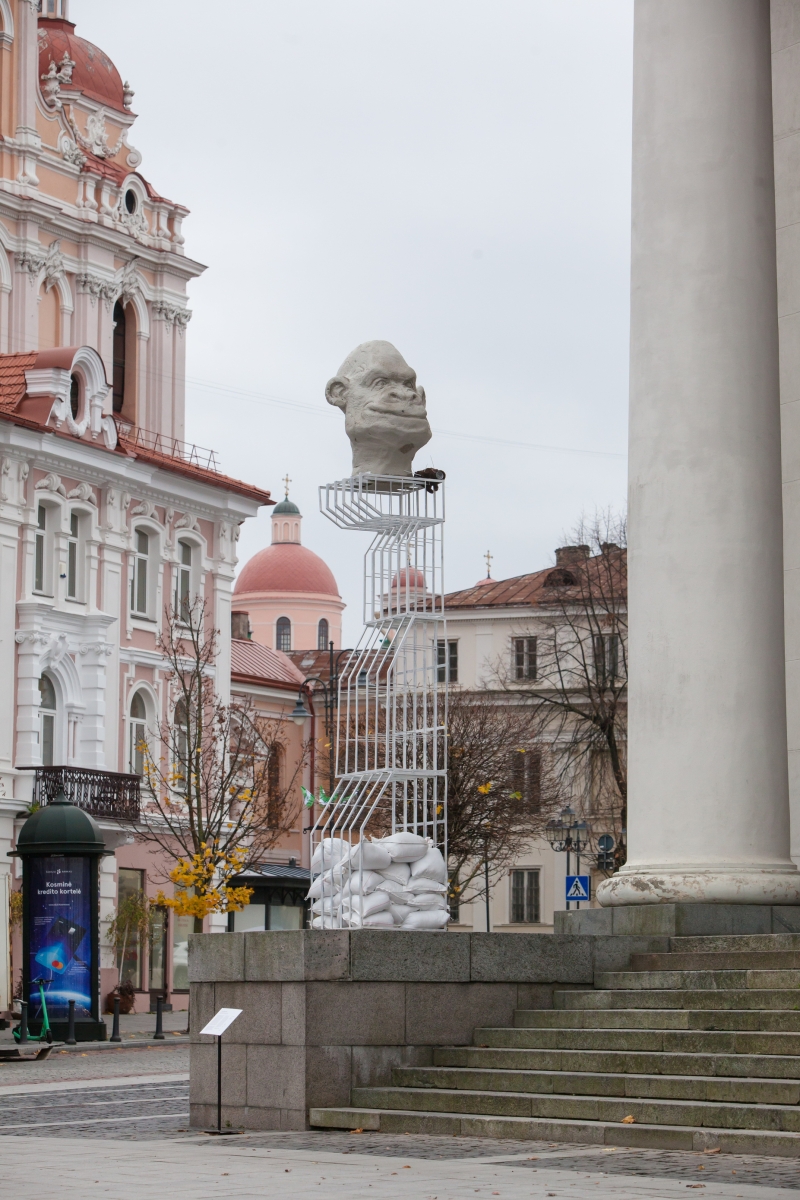
Donatas Jankauskas-Duonis. Lašininis & Kanapinis (Porky and the Hempen Man), Vilnius Town Hall, 2022
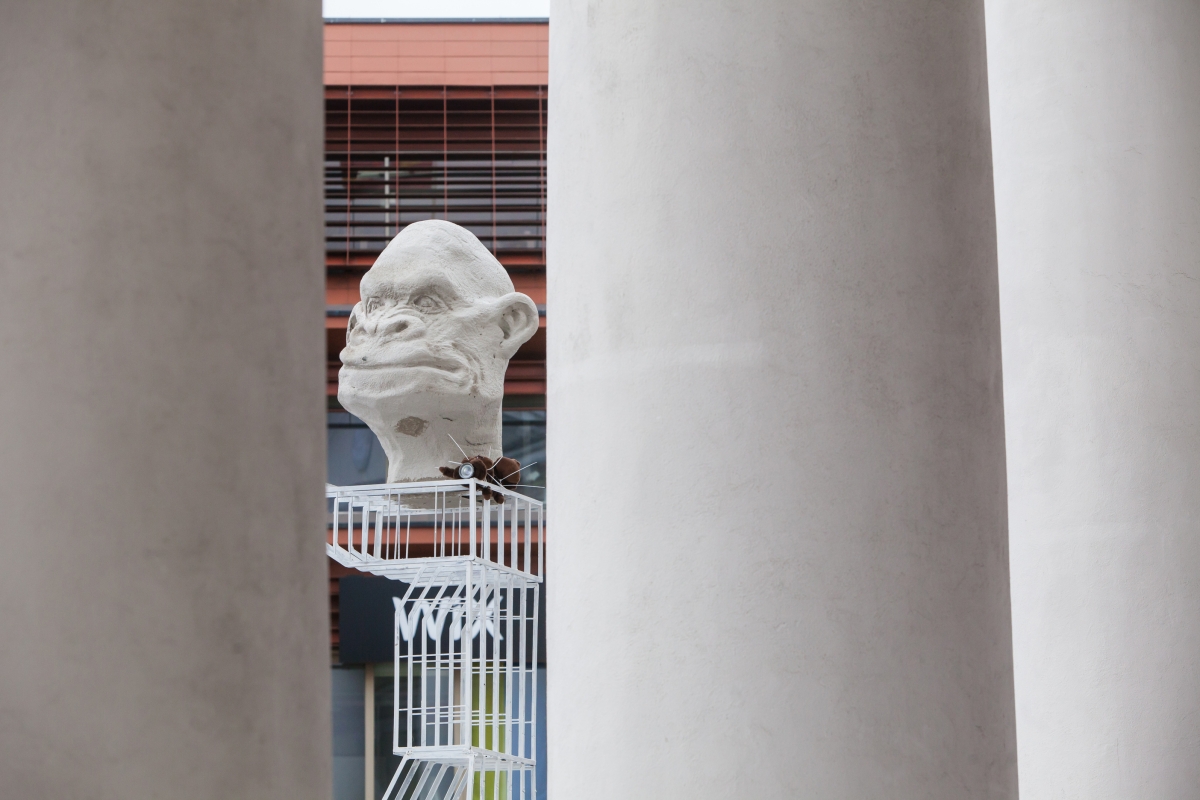
Donatas Jankauskas-Duonis. Lašininis & Kanapinis (Porky and the Hempen Man), Vilnius Town Hall, 2022

Donatas Jankauskas-Duonis. Lašininis & Kanapinis (Porky and the Hempen Man), Vilnius Town Hall, 2022
AN: Is that why you use elastic materials?
DJ: Yeah, the surfaces are made of polyuria, the material swimming pools and roofs are made of. A very expensive invention. This material doesn’t overheat in America or the Emirates, where it’s hot, and it can last up to thirty years. The warranty is for thirty years, after a high heel pierces it. But I’m told: ‘I don’t get you. Cast it in bronze, and it will stay there for a hundred years.’ ‘I don’t know,’ I reply. ‘A wild Russian might come and recast it as a war cannon.’ But if he comes and sees that there’s an ape in someone’s inner yard [laughs] like the Saint Marys all over Warsaw. What could be done with them? You can’t recast them or anything. In a democratic world, the apes and Marys can help signify spaces [we both laugh].
AN: You populated Vilnius with apes.
DJ: I was afraid it was going to be like the angels.
AN: Is it a response to the angels then?
DJ: The concept didn’t take root. There was this very naughty Saulus (that’s what I called him) and the Gravity club. Somehow, I ended up there. Well, I don’t know, usually, you end up there in the early morning. So Saulus told me: ‘You know what, carve for me, like, fifteen devils [laughs]. With a kitchen. The first will sit right above the entrance to Gravity.’ I told him it wasn’t my thing at all, and I didn’t want to do it. How can one live with that? I’ll die and I want my kids not to be ashamed of me. I don’t make devils. Although many people say Duonis does everything.
But what is courage? I, for instance, evaluate artworks based on courage. Navakas and Urbanavičius: what they do is courageous. I’m learning from them how to be myself.
AN: Let’s go back to Lašininis & Kanapinis. Was it a commission, a task?
DJ: A task … for the nerves. But you live off tasks. The further you go, the less time you have. Less good health, too. When I look at my colleagues, I think, well, damn it, we are all alike. We take on these projects, everything goes well … I don’t know. Oh, gosh, I think I’m getting far too tired.
In principle, I adapt to the situation I’m in what I began doing earlier. So, I drew them something like eight years ago. There are two drawings. Every now and then, I find them and look at them. I constantly dream of an orderly filing system, with drawers labelled according to the year: that’s how it actually should be. I’d like to have that. Even when I am working with a computer, a mouse and a keyboard, I put two Whatmans beside me and write everything on them. And the Whatman becomes a mess from my dirty hands, gloves and tools. It has all the dates, names and undertakings on it: what happens tomorrow, my diary, symbolic drawings, titles, thoughts, phone numbers, account sizes, and estimates. An idea appears suddenly, so you capture it. It’s not the time to draw nicely. It’s not the time I create. But I can’t live without paper. Then, from the draft, I perform an ideal (or so I believe at the time) drawing.
When I was asked to make something for the facade of the Town Hall, I found a six-year-old idea, just as for any other project.
When I draw, I’m focused. I have the paper, I spread out all the material I am about to draw with, and try them all. Yellow or green felt-tip, pencil, charcoal, and the rest. Then I begin. I know what I’m going to do. It’s not just anything.
My mother has collected all my drawings, even from kindergarten. When I look at my old drawings, I recall the smell of my grandmother’s cooking: buckwheat, potato soup, or Samogitian potato mash with flower and pork (pusmarškonė). In the meantime, I’m drawing. The Russians and the Germans are at war with each other, running around. I remember the smell of my kindergarten toilets. But you are drawing, saliva dripping from your mouth. If the saliva is dripping like that, it means I am drawing extremely well. Because I am so focused. Now I want to draw just like I did back then, so if my saliva isn’t dripping, something’s wrong.
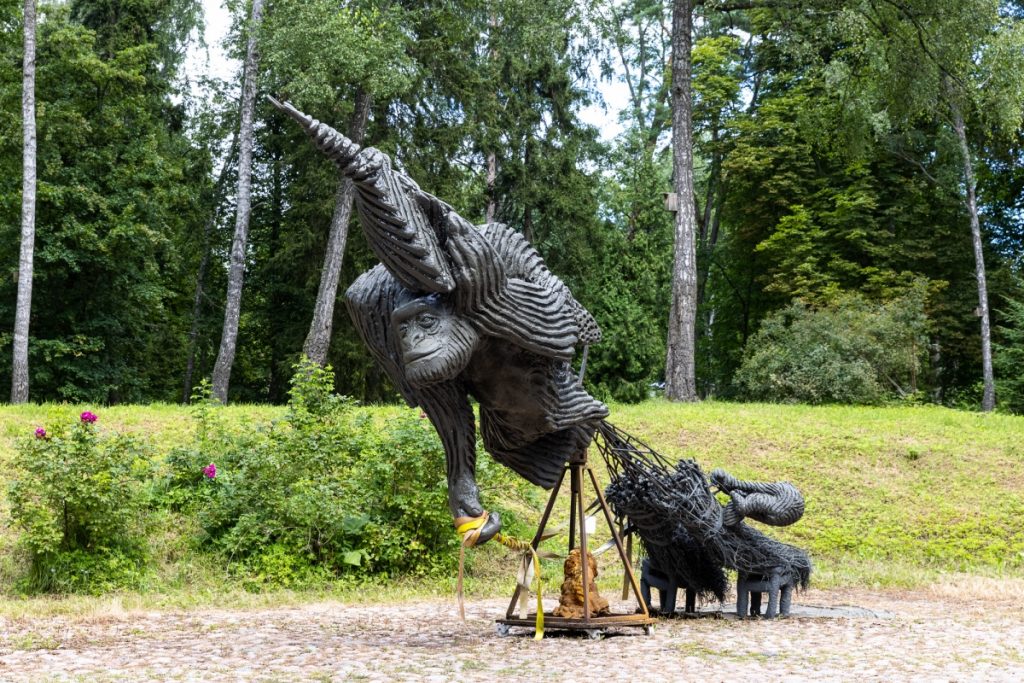
Donatas Jankauskas-Duonis. Art festival “(Re)kolekcijos” at Užutrakis, 2022. Photo: Giedrius Akelis
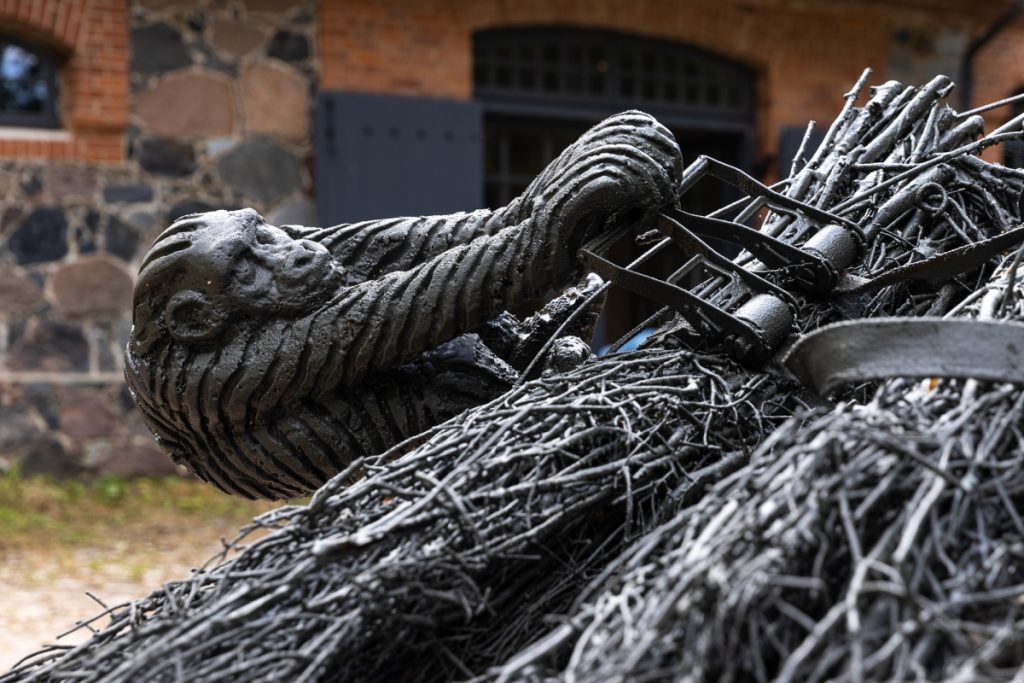
Donatas Jankauskas-Duonis. Art festival “(Re)kolekcijos” at Užutrakis, 2022. Photo: Giedrius Akelis
AN: How do you think of your titles?
DJ: You know what: in fact, I am colourblind. I can see better in the dark. You can’t see the way I can. And when someone asks me to say what I see, I have completely different names for the surroundings, colours and forms. The words that come to mind are completely different. First, I look at some artworks, name them in my own way, and only then read the artist’s titles. I remember standing in front of the cut canvases by Zimblytė, hanging in the funeral parlour on Olandų Street in Vilnius. I immediately saw a clear image of the beyond. It was very powerful.
I think my success lies in the fact that my works are about something completely different. And my titles are like nicknames. I don’t hide my motto any more: Minor literature, great scale. You act out what’s in your head. You know, sometimes I hear people talking about my work at an exhibition or somewhere in the city: ‘What do you eat to create something like that?’ That’s humiliating to me. But, conversely, I think: ‘What do you do so you don’t understand it?’
I really want to be asocial. And I don’t want to be liked. What can one do to be completely asocial? Somehow, it’s got to the point where everyone wants apes from me. And I have them, Jesus Christ, I do. I’m trying to gather them all, I don’t know if I can make it in time. I’m currently working on this tale about how apes got bored on planet Earth, made a rocket, and flew off, say, to the Moon. [We both laugh.] Or anywhere else. I’ve had my plasticine ready for a few years now. I just need to make all the little fingers, and something like The Adventures of Munchausen. That’s what it’s all about. And the idea bank is the Marčiurlionis Album. Cathartic! Have you ever said that about a beautiful sentence of yours?
AN: It happens.
DJ: When you say, wow, I’ve thought of something there! And then it starts. How much will it cost? This action, that action. Family, friends, children and parents. Everything is interconnected. It can’t be any different. I used to be hyperactive as a child. But I had my little corner behind the cupboard, behind the curtain on the windowsill. I’d stand there with a pencil or a felt tip in my hand.
AN: And you’d draw.
DJ: Well, yeah. All sorts of déjà vu. I liked that déjà vu feeling. It’s me behind that cupboard, that curtain; my mother’s cactuses are on that windowsill. I am looking through the window at the basketball court outside, although there are no hoops, no one is playing. Then the lunch break begins at a nearby factory. All the men and women go home for lunch, because the canteen food is bland and expensive. There was usually a home-help at our home. So, my father would come home across the yard. It would be exactly half-past twelve. Everyone ate and left again. You can imagine: déjà vu. The same film over and over again.
Back then, I didn’t understand it. But once you get it, you begin using it elsewhere too. That is the case with all the seven or nine Marčiurlionis books. Each book has the same reproductions, and I draw on them. You try one, you fail; you try another, and fail. But the third one turns out fine. So, you learn not to repeat your mistakes, when it dawns on you, that is [laughs]. I’ve never finished a full book. I’ve tried though. However, I’ve compiled one book: it was a collection of my best hallucinations from all the other books. It was a good opportunity to review the full collection of those apparitions. Some books have nicknames, for example Sparks. I ‘draw’ with an eraser in that one: I erase and make sparks.
Čiurlionis has all these silences. For example, there are some canvases of his with such little fingers; even pure eroticism in some, a pretty female ape lying on the sand. It’s loaded with all sorts of things. The Japanese understand that surreal Symbolism and read it as though it is their own. While we add a national vintage layer.
So, people give me those books. I ask them: ‘Do you have Čiurlionis?’ They say: ‘Why? Do you need it?’ And they give it to me. The prints are great. I’ve spent a lot of time talking with Jonas Petronis, a folk painter who worked at a printing press in Kaunas. He mastered the colours of the reproductions, the whole ancient machinery. He knew his colours. He was well-known in that area. You know, if you want to make a good reproduction, you need a really good colourist who can look at the original and calibrate the machinery so that the reproductions match the reality and every book looks the same. And yet, when you put those books side by side, you can see a difference. The differences are very small. So, like a DJ, I open the same reproduction in all the books and compare the hallucinations I get from each of them. I can tell if something’s faded in one of the books, if the printing was faulty, while another book is fine. So, I do the same thing myself: I put a few dots in one book, and in another I make the distance between them slightly different: it produces a completely different concept [laughs]. Sometimes I mix works from the same series. I open the books and make my own narrative. And that’s what kicks off the processes. The important thing is not to wag too much. To stay close to the Earth and not produce any Utopian versions; because otherwise, you die.
AN: Are those processes long?
DJ: It took me three years to make that bathtub, for instance. By the way, a journalist asked me what my sculpture Rytmetis [Morning, Paupys district, 2022] symbolised [laughs]. I said my sculpture symbolised the morning [laughs].
AN: People want you to clarify what the morning means.
DJ: That’s right, but as I’ve said, my literature is brief. They ask in brief, and that’s how I answer. When in reality you need to take a comfortable seat and talk all night about what morning is, about the imperfections of the enamel surface of a cast iron bathtub, or the tin plate sound-proofed with sealing foam. Or, say, Father brings carp to the house in the country. ‘Well,’ he says, ‘we don’t want to eat them just now, let’s keep them for a while.’ They swim in our bathtub for three days. So, you don’t bath while they’re there. Or like in Japan: first the man takes a bath, then the woman, then the children, then the dog, all in the same water [laughs]. That’s their order.
AN: So, you want your sculptures to annoy people?
DJ: Annoy, you say … Why can’t I express what annoys me? There was this Carlos guy, a Spanish speaker from Bolivia, who went to my school and lived in Vilnius. He’s gone now. He would give guided tours of Vilnius. So, he brings his group to the Gediminas monument in Cathedral Square and tells the legend about how Gediminas dreamt of an iron wolf howling. Then those Spanish-speaking tourists ask (almost always): ‘If the legend is about an iron wolf, why is the monument made of stone?’ Why the heck not?
My reply to the iron polyester howling wolf was a howling ape carved out of plastic [Visi kauk, 2022] in Antakalnis, next to the district administration. I’m not trying to annoy anyone. It’s just sarcasm or irony on common ground. So, I’m thinking, maybe it’s good to tease a little, to look at all the emotions. The same howling ape used to stand in Klaipėda by a withered fir tree. Maybe some people are annoyed by everything. Others are positive about everything. We need them all. Otherwise, it would be boring. This is like something from Šluota [Broom] magazine.
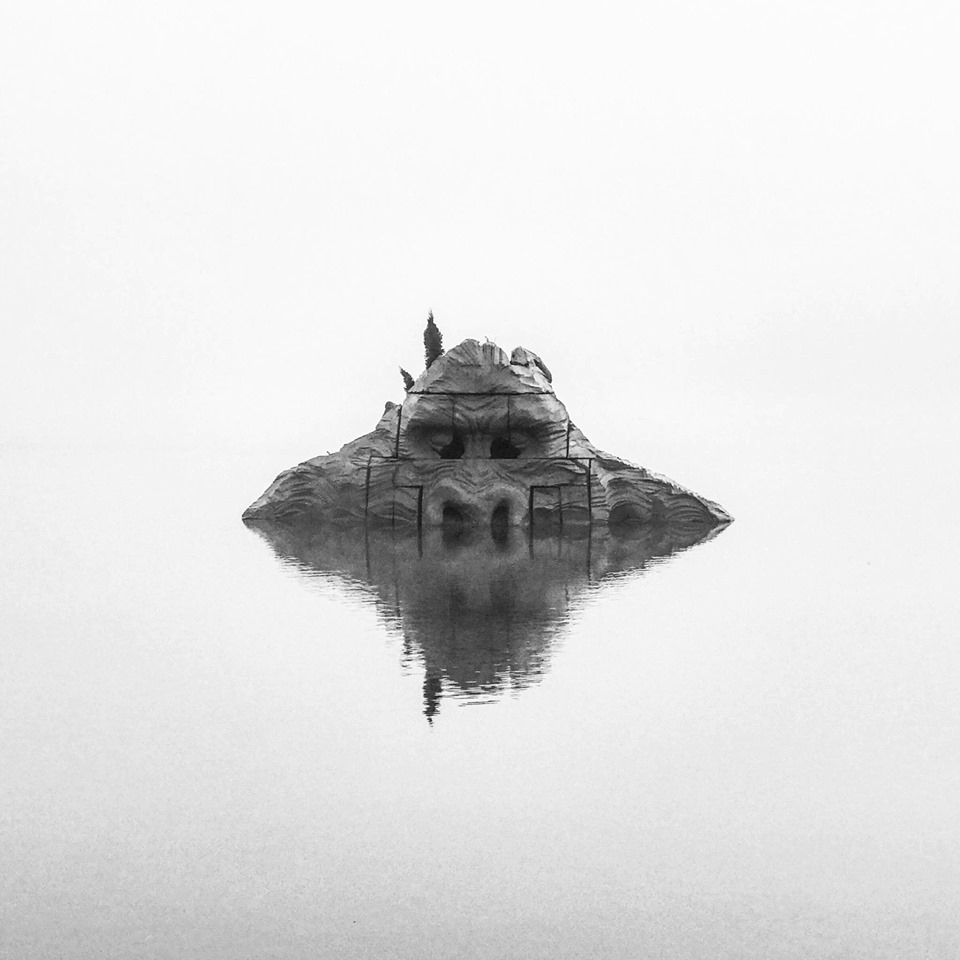
Donatas Jankauskas–Duonis, “Uneasy”, Šiauliai, 2018. Phot: Virginijus Kinčinaitis
AN: Your work Neramu [Uneasy, 2018] might come across as a desecration of Čiurlionis.
DJ: First of all, when I look at that painting by Čiurlionis, I feel uneasy [laughs]. Let them come to my door, or else let me come to theirs. The point is, tranquility is reflected in the water. And yet the form itself is unsettling. When I was looking for a place to work, the landscape at Lake Talkša in Šiauliai was the most ideal. The calm was simply idyllic. Unfortunately, it is subject to natural forces. Virginijus Kinčinaitis tells me that Neramu doesn’t stay still, it wanders around the lake. Somebody pulls a wire and keeps the sculpture for a few days, and then becomes uneasy and lets it go. After some time, the locals accidentally cut it with the wire. The director of the rowing centre and the workers helped me to collect the pieces from the lake, and then I put them together and fixed them in the previous form, and was about to put the sculpture back into the water, but then Virgis told me: ‘We’re giving it to you. Because they didn’t want to take care of it any more, it’s a lot of work.’ I said: ‘Sure.’ So, the municipality writes off the artwork. But it is utilized by the artist himself. Where should I put it? I was offered to take it to the Kaunas Botanical Garden, but I’d like to bring this one home.
AN: To the Ape Museum?
DJ: It doesn’t matter. But also, to find a ‘puddle’ of my own. To throw the sculpture wherever I like, whereas I wouldn’t like to take, say, Gandolfini [Tony Soprano, 2009] with me. I wanted to take it and bury it in Juozas Laivys’ cemetery.
AN: That would require a deep hole.
DJ: It is the most genuine sculpture I’ve ever made; everything else I call sculptural graffiti.
AN: It welcomes and sees off trains in style. When you were talking about courage, I thought to myself, well, that was courageous. How did it get there?
DJ: The Peronas bar asked me to put something there. I’ve always liked collaborating with bars. There was a photograph of me, a Čiurlionis-style portrait I had taken for the retrospective at the CAC in 1999 in the former Tappo d’oro winery. I had grown some hair and a moustache, although I’ve always been bald, since the seventh grade. But I knew my hair was curly. So, I grew it to be like Čiurlionis, and Kemežys (may he rest in peace) took a photograph of me. When people applied for a job there, a key question in the interview was: ‘Who is that man on the wall?’ A test. Many would say it was Čiurlionis [laughs].
AN: But the resemblance is there.
DJ: Yes, if you want to make a legitimate joke, everyone has to have a sense of humour. Sometimes you are afraid to talk to someone, you can see them getting scared and running away.
AN: For your graduation from the M.K. Čiurlionis School of the Arts, I remember you made a perfectly realistic sculpture called Brother.
DJ: There, my brother is walking. [He points at his brother Paulius, who has just returned from the USA and is waiting for our conversation to end.]
AN: Then, to my surprise, I saw your apes on the balcony at the Vilnius Teacher’s House [Balkone, 1995]. The hands next to the MO Museum, Victor and Victoria [2004], resemble them a bit, they seem out of place in the scale of the city.
DJ: The story behind them is that they were cut: around a metre is missing from the wrists. I made them for the Netherlands: they were put in front of the prime minister’s window. There’s a little tower there. I went there with those hands; they were to be put on the bank. The wrists had to emerge from the water, but I didn’t know the canal was so shallow. A carpet covers the whole bed of the canal, and there’s a pipeline underneath. Freon flows through the pipes and freezes the pond for Christmas. The queen of the Netherlands goes there every year on skates to light up the Christmas tree with children.
So, I cut the wrists off, and said: ‘Give them back to me together with the rest of the hands.’ But they didn’t. So now that’s how it is. They’d look perfect with the wrists.
Meanwhile, I had the idea because it’s The Hague, the International Court of Justice [laughs], the city of the king and queen, you know that. The gesture means different things in different parts of the world; it doesn’t necessarily mean victory. The story behind the title is this: I was living in a block of flats on Subačius Street. There was a neighbor called Viktoras. Our balconies were right next to each other. One day, Viktoras’ wife Daiva came back home and put the key in the lock; however, Viktoras’ key was in the lock on the other side, stuck. So, she couldn’t unlock the door. She called me and said: ‘What should I do?’ I went on to his balcony, stepped into his home, and found Viktoras asleep, blanked out on vodka. I shook him a bit. He opened his eyes, lifted his hand, and made the Victory sign [laughs]. That’s the kind of joke you always remember. I had drawn these signs in the Marčiurlionis book. There are lots of them there: whoosh! through the trees, one tree seems twisted, it looks like a harp.
You know, Čiurlionis is full of that. If you don’t look at his drawings, you won’t understand his paintings. His drawings are like a diary, an open, poured-out book. There are all sorts of sayings, and you can see his sense of humour. There’s even an ape in one of his drawings. Check it out. A portrait of his brother Petras, I think. A drawing. There’s an ape on a branch. A little man is running away from a tiger on a little winding road [laughs].
Now, go to one piece or another and try to think how it was. It was horrible. Shall we go for a smoke?
AN: Let’s go.
DJ: I come to the city: trolleybuses, concrete.
AN: I can see the roofs of trolleybuses from my balcony.
DJ: But you take them, too, don’t you? Oh, what a trolleybus, get out of here. I’d love to …
AN: All of your apes could settle there.
DJ: Now you’ve made me do it, that’s it. I’m buying a bus and driving it to the Ape Museum. We’ll visit all the apes of Vilnius.
AN: I’d like to travel on such a bus. [We both laugh.]
AN: How many apes are there in Vilnius?
DJ: It was a joke. I don’t know. Hang on, there are three there, four, five that I know about. Yeah, let’s make it five.
AN: And then we drive to your Ape Museum. How many do you have there?
DJ: I don’t even know. That museum requires an audit … I don’t have so many people.
If I started counting … Can you imagine? Sometimes I get a call: ‘Can we come?’ Just call me to make sure I’m there. The University of the Third Age comes. It was hilarious. A firefighter runs up to me and says: ‘Make some space’. There are plenty of cars, and they are all trying to get into those five square metres. I didn’t think so many people would turn up. I’m marking the tickets and starting to tell the story, but people don’t fit inside the museum. I’ve already started, though. I recalled my day at the market, and what I saw, in my beautiful Sudovian. Cool, that’s actually awesome. So, I thought, darn it, there’s a proper prehistory to all of that. I like that.

From the Artworks Cemetery Archive (burial of the sculpture by Donatas Jankauskas-Duonis), Narvaišiai, 2019. Photo: Juozas Laivys
AN: I also wanted to ask you about Sportbatis [The Sneaker].
DJ: I remember walking by the sea and coming across a sneaker. A good one, Nike. My sneaker literature is that the sea washes out only a single sneaker. The other one isn’t anywhere near you. The next one you find is an Adidas, for the same foot. But you walk in them. There’s another ape for you.
AN: We were checking it out in the CAC yard, and concluded that vandals must have torn the sneaker at the edges.
DJ: That’s right, then I restored it.
AN: So, it wasn’t an embodiment of the non finito technique?
DJ: Non finito, yes. But it wasn’t supposed to be so damaged. The shabbiness was thought of though. I deliberately travelled the River Minija, from Plungė to Norvaišiai, to visit Juozas, so it got scratched on the way.
AN: So, you made a boat from it? Did it float well?
DJ: Yeah, yeah, superbly. You can sleep in the sneaker like in a tent. [We both laugh.]
That was the idea. Then I brought it back and put it there, scratched and everything. You know how it is, you buy sneakers, and the plastic begins to fade as the material absorbs UV light. If you visit the sneaker occasionally, you can see it change.
But there’s a restaurant nearby. Local drunks come out, climb over a fence, and continue bustling in the CAC yard, and the best place to sit is that sneaker [laughs]. The sitters broke it, but I fixed it. The CAC helped me, they paid for it. I sprayed and glued it, but it lasted a month. Kids like to jump around on it too. It’s interesting to see it live. What if you just threw it on a street? Such a useless object lying around. Nobody needs it, it wanders around a little, the wind blows it over, and someone puts it back in a different position, like in ping pong. It changes its place as though in the wind. It’s awesome, for it to walk like that. Three steps forward, then backwards, then fall. Lean.
For example, there’s the clock in Prague. What a unique thing it is, isn’t it? I think it’s the reason why everyone goes there. And we don’t have that. Vilnius doesn’t have a clock.
I have a wonderful (former) classmate called Julija Ikamaitė. Her cousin used to play the Cathedral bell tower’s carillon. When she played, Julija and I would climb up the tower. One of the faces of the clock points towards the University. There’s a door in the clock face, close to the hands. I put my head outside and go: ‘Koo-kooo, koo-kooo!’ [laughs]. People start looking around: this can’t be. It would be great if the Vilnius Cathedral carillon played something by Čiurlionis. Maybe then tourists would gather to listen.
AN: It was a Vilnius clock performance then.
DJ: That’s why I say: What is attraction? I’ve put a few apes in my yard. That yard is Lithuania [laughs]. Not everyone understands. They keep silent, and they don’t know, or they are afraid to ask.
I once made a group of intellectuals laugh very hard. They were having a deep discussion on some transcendental issue. I listened for a while, and then said: ‘Listen, I know everything.’ They glanced at me. A few seconds of awkward silence. Then they understood, and we all started laughing. That would be the first words by an ape that humanity would hear [laughs]. I like saying that. What about the apes? They know it all. And they keep it to themselves. When you observe apes at the zoo, you realise that’s how it is.
AN: What do you plan to make now?
DJ: I’d love to turn the Apiece gallery on Čiurlionis Street in Vilnius into a skyscraper. If only Aušra got funding. I once saw a two-part cartoon that made me laugh so hard. One image depicted King Kong hugging the tip of a skyscraper in New York. The second showed a huge office in the skyscraper: the members of the board that were gathering for a meeting could see King Kong’s genitals sticking to the window from the inside [laughs]. Fuck, I really want to do that, I don’t know. And it would be untitled.






























